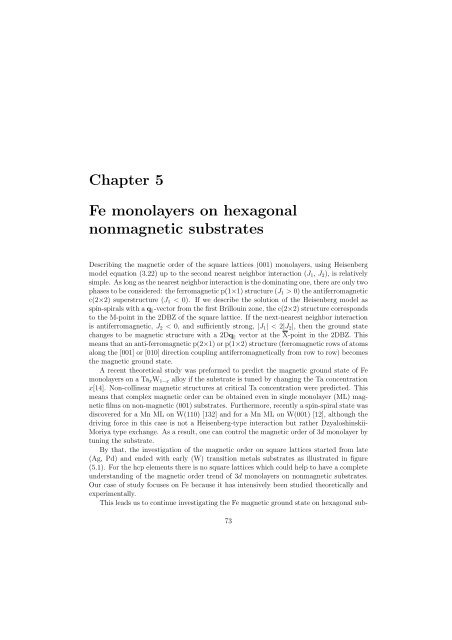Ab initio investigations of magnetic properties of ultrathin transition ...
Ab initio investigations of magnetic properties of ultrathin transition ...
Ab initio investigations of magnetic properties of ultrathin transition ...
You also want an ePaper? Increase the reach of your titles
YUMPU automatically turns print PDFs into web optimized ePapers that Google loves.
Chapter 5<br />
Fe monolayers on hexagonal<br />
non<strong>magnetic</strong> substrates<br />
Describing the <strong>magnetic</strong> order <strong>of</strong> the square lattices (001) monolayers, using Heisenberg<br />
model equation (3.22) up to the second nearest neighbor interaction (J1, J2), is relatively<br />
simple. As long as the nearest neighbor interaction is the dominating one, there are only two<br />
phases to be considered: the ferro<strong>magnetic</strong> p(1×1) structure (J1 > 0) the antiferro<strong>magnetic</strong><br />
c(2×2) superstructure (J1 < 0). If we describe the solution <strong>of</strong> the Heisenberg model as<br />
spin-spirals with a q�-vector from the first Brillouin zone, the c(2×2) structure corresponds<br />
to the M-point in the 2DBZ <strong>of</strong> the square lattice. If the next-nearest neighbor interaction<br />
is antiferro<strong>magnetic</strong>, J2 < 0, and sufficiently strong, |J1| < 2|J2|, then the ground state<br />
changes to be <strong>magnetic</strong> structure with a 2Dq� vector at the X-point in the 2DBZ. This<br />
means that an anti-ferro<strong>magnetic</strong> p(2×1) or p(1×2) structure (ferro<strong>magnetic</strong> rows <strong>of</strong> atoms<br />
along the [001] or [010] direction coupling antiferro<strong>magnetic</strong>ally from row to row) becomes<br />
the <strong>magnetic</strong> ground state.<br />
A recent theoretical study was preformed to predict the <strong>magnetic</strong> ground state <strong>of</strong> Fe<br />
monolayers on a TaxW1−x alloy if the substrate is tuned by changing the Ta concentration<br />
x[14]. Non-collinear <strong>magnetic</strong> structures at critical Ta concentration were predicted. This<br />
means that complex <strong>magnetic</strong> order can be obtained even in single monolayer (ML) <strong>magnetic</strong><br />
films on non-<strong>magnetic</strong> (001) substrates. Furthermore, recently a spin-spiral state was<br />
discovered for a Mn ML on W(110) [132] and for a Mn ML on W(001) [12], although the<br />
driving force in this case is not a Heisenberg-type interaction but rather Dzyaloshinskii-<br />
Moriya type exchange. As a result, one can control the <strong>magnetic</strong> order <strong>of</strong> 3d monolayer by<br />
tuning the substrate.<br />
By that, the investigation <strong>of</strong> the <strong>magnetic</strong> order on square lattices started from late<br />
(Ag, Pd) and ended with early (W) <strong>transition</strong> metals substrates as illustrated in figure<br />
(5.1). For the hcp elements there is no square lattices which could help to have a complete<br />
understanding <strong>of</strong> the <strong>magnetic</strong> order trend <strong>of</strong> 3d monolayers on non<strong>magnetic</strong> substrates.<br />
Our case <strong>of</strong> study focuses on Fe because it has intensively been studied theoretically and<br />
experimentally.<br />
This leads us to continue investigating the Fe <strong>magnetic</strong> ground state on hexagonal sub-<br />
73

















